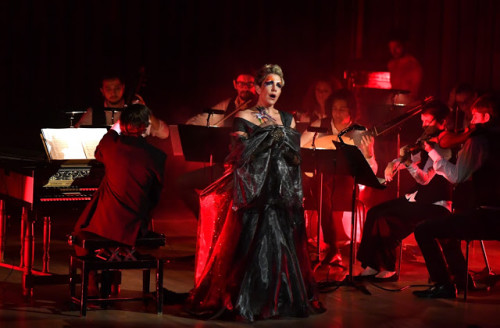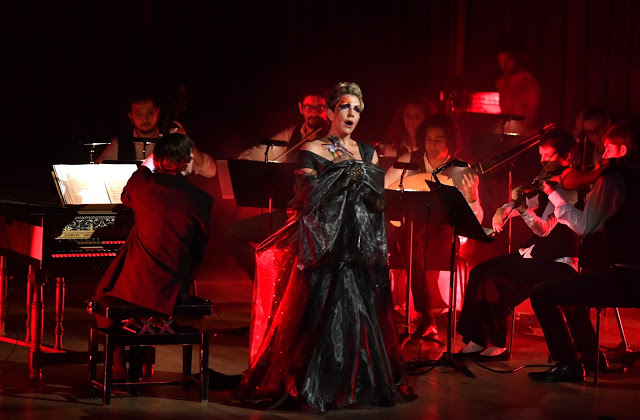 Canada Joyce DiDonato – In War and Peace: Harmony through Music: Joyce DiDonato (mezzo-soprano), Manuel Palazzo (dancer/choreographer), Il Pomo d’Oro / Maxim Emelyanychev (conductor), Orpheum Theatre, Vancouver, 30.11.2016. (GN)
Canada Joyce DiDonato – In War and Peace: Harmony through Music: Joyce DiDonato (mezzo-soprano), Manuel Palazzo (dancer/choreographer), Il Pomo d’Oro / Maxim Emelyanychev (conductor), Orpheum Theatre, Vancouver, 30.11.2016. (GN)

Songs of War
Handel – ‘Scenes of horror, scenes of woe’ from Jeptha; ‘Pensieri, voi mi tormentate’ from Agrippina; ‘Lascia ch’io pianga’ from Rinaldo
Leo – ‘Prendi quel ferro, o barbaro!’ from Andromaca
De Cavalieri – Sinfonia Rappresentatione di anima e di corpo
Purcell – Chaconne in G minor; ‘Dido’s Lament’ from Dido and Aeneas
Gesualdo – ‘Tristis est animam mea’
Songs of Peace
Purcell – ‘They tell us that you mighty powers’ from The Indian Queen
Handel – ‘Crystal streams in murmurs flowing’ from Susanna; ‘Da tempeste il legno infranto’ from Giulio Cesare; ‘Augelletti, che cantata’ from Rinaldo
Arvo Pärt – Da pacem Domine
Jommelli – ‘Par che di giubilo’ from Attilio Regolo
While a well-known President-Elect is currently proceeding on his 10-city ‘Thank You’ tour, giving indulgent performances at double-forte volume in repertoire that seems hollow and insubstantial, Joyce DiDonato continues her alternative 20-city tour that now essentially asks the question: How does one find inner peace and comfort when questionable displays like the former are allowed to persist and disintegrate the soul? This is a concert about rejuvenation and the restoration of freedom and lightness of spirit. It nurtures a musical metaphor that suggests inner peace comes from being in touch with timeless natural processes that guard everyone’s humanity and which ultimately transcend the unsettlingly ‘bad’ performances that haunt the world these days.
DiDonato negotiates her ‘War and Peace’ with subtlety, using just enough dramatic strength and a few extra-musical effects (stage smoke, lights, simple video images and a bare-chested dancer) to take us from a world of conflict and burden to one where our lightness of spirit and perception of love are restored. This is easier said than done: the singer’s immense skill is in lightening the initially dark fabric in imperceptible steps to allow the listener to achieve a wonderful freedom at the end. That we achieved this blissful state without being quite conscious of how we got there testifies to pure DiDonato ‘magic’. Her young Il Pomo d’Oro orchestra, directed most attentively by Maxim Emelyanychev, certainly helped things along, artfully moving from vibrant attack to more searching, suspended postures as the music unfolded. The stage effects provided another layer of meaning to this transition, underpinning the life force of the experience without exaggerating it. Even though DiDonato has now performed In War and Peace a good many times and recorded it, this rendering still seemed absolutely fresh and uninhibited. One reason that the singer hinted at in her brief comments at the end was that she was now in Canada! This was in fact her Vancouver debut.
It is unnecessary to rehearse all the many strengths of DiDonato’s singing: her sterling precision and enunciation, her luminescent projection and sense of phrase, and her undoubted emotional absorption. All are quite sufficient to produce an entrancing event. This concert derives from her long experience in Handel, fleshed out by small ventures into Purcell, Gesualdo and more obscure names such as Leonardo Leo and Niccolo Jommelli. The only modern composer represented was Arvo Pärt.
Certainly the world of pain and torture was present right away in her Songs of War. The singer sat frozen in her chair at the back of the stage even as the audience entered, painted in a full costume of woe and despair, then springing to life in Handel’s ‘Scenes of horror, scenes of woe’, to be followed by Leo’s ‘Prendi quel ferro, o barbaro!’. DiDonato obviously relishes the extreme drama in both, bringing out their jagged lines, incisive vocal force and overwrought emotions, while the orchestra played their part by contributing estimable drive and frisson. This was operatic singing in full flight, and while one might be hard pressed to say it was today’s ‘authentic’, the orchestra did use period instruments, and I found nothing distracting about the overall sound or style.
The interesting thing was how this rougher fabric began to yield moments of tenderness and repose even when the subject matter was still forbidding. Contemplative space opened up in Cavalieri’s ‘Rappresentatione di anima e di corpo’, with Emelyanychev’s haunting cornetto coaxing pastoral feelings. Purcell’s Chaconne was followed by one of the great summits of them all, ‘Dido’s Lament’, quite riveting in its involvement, rich characterization and the fluidity of its legato phrases. Perhaps I was taken back to Janet Baker at points. Yet, somehow, the fever passes at this point. In the last two pieces of this sequence, Gesualdo’s instrumental ‘Tristis est anima mea’ and a slow, concentrated and vocally adventurous ‘Lascia ch’io pianga’ from Handel’s Rinaldo, a degree of natural relaxation is restored: greater life could be gleaned in the expression. Whether fully intended or not, I thought it was a stroke of genius to start the emotional transition here, rather than just moving on to the Songs of Peace tabula rasa.
The second half did just this, Di Donato’s bereft look of the opening now transformed by new Vivienne Westwood designs and drapings – as if following a celestial beacon towards love, freedom of spirit and outright frolic. After Purcell’s transformative ‘They tell us you have mighty powers’ from The Indian Queen, Handel’s ‘Crystal streams in murmurs flowing’ started the road home. What I liked about the latter is that it conveyed a lovely, fresh innocence and intimacy: perhaps the pain of war is objective while the flowering of human joy can only be intimate. Handel’s always-telling ‘Da Tempeste il legno infranto’ again left me in awe of DiDonato’s virtuoso skill. I had very recently seen young American vocal wizard Amanda Forsythe perform this aria, and thought it was stunning how she could cut so quickly between varying emotional and musical postures. Yet DiDonato was demonstrably better, tossing all the trills and accompanying difficulties off with even greater ease, fluency and vocal variety – like it was the simplest aria in the world. And there was a subtle lyrical underpinning to it all. The dancer – who had played a somewhat amorphous role in the first half – came fully to life as the custodian of love and feeling in Pärt’s Da pacem Domine. The final two arias brought home all the requisite delight: Almirena singing to the birds from Rinaldo, which featured the recorder soloist skipping about capriciously to the music, and Attilia’s joyous aria ‘Par che di giubilo’ from Jommelli’s Attilio Regolo, which exhibited DiDonato’s full artistry and could not help but reveal her smiles alongside. The encore was a beautifully poised and restrained account of Richard Strauss’ ‘Morgen’.
All of this was most impressively done. As a vocal concert, it displayed the sheer range of Joyce Di Donato’s talents and her obvious charisma. As an artistic mission, there can be little doubt about its sincerity: it neither over-projected nor sentimentalized its message. And as a dramatic experience, it worked its magic most artfully, and likely brought everyone a momentary emancipation from the uncomfortable events we have suffered through recently. Of course, I probably shouldn’t have watched the news the next morning.
For an alternate take, see Jim Pritchard’s review of the Barbican performance a week earlier.
Geoffrey Newman
Previously published in a slightly different form on http://www.vanclassicalmusic.com.
